ISSN ONLINE(2278-8875) PRINT (2320-3765)
ISSN ONLINE(2278-8875) PRINT (2320-3765)
S.S.S Kalyan1, S. Shanmukha Madhava2, S. S. Satya Parthiva3
|
| Related article at Pubmed, Scholar Google |
Visit for more related articles at International Journal of Advanced Research in Electrical, Electronics and Instrumentation Engineering
Although there is increase in science & technology, it is impossible to stop natural disasters but can prevent the extent of human and heritage loss with proper communicative measures. At times, when a great havoc occurs in any part of the globe, there is a possibility of power failure, and all other systems based on it. To overcome this and to help mankind we have no other go, but to go for H.A.M radio. Though it is outdated, at disastrous times it is updated, because it works even if no power is available on HF & VHF frequencies i.e. from 3MHz—300MHz. This paper enhances the use of solar power for effective communication and considering ionosphere which plays a key role in enhancing HF frequency. As ionization increases communication will be more effective. The HF frequency goes to every nook and corner, as they previously couldn’t. The disaster in sun due to imbalance in magnetic field develops spots called sunspots. The flare ejects clouds of electrons, ions, and atoms through the corona of the sun into space. The solar dust reaches the earth within a day or two after this event. This solar dust causes more ionization in ionosphere region of the earth. These ionized atmospheric layers reflect HF waves more effectively which is useful for improved communication.
Keywords |
| Solar Inferno, Sunspots, Solar Flares, Ionosphere, Communication, Ionization. |
INTRODUCTION |
| Sun is our nearest star, can be aptly called as FIRE BALL whose diameter is 1.4 million km and maintains a distance of 92,935,700 miles from the earth crust. Life on earth depends on Sun. It is the Sun that keeps our planet earth warm enough. A lot of radiation action takes place in the space between sun and earth which is needed for earth to survive. Sun radiations are utilized in the form of solar energy for survival of all the species and it is also scientifically utilized. This solar energy is used in gadgets such as solar cells, solar water heaters, solar cookers and many more. In this section we are now going to utilize the solar radiation for effective communication. The disasters in and on the sun are useful for enhanced communication. |
II. THE IONOSPHERE |
| Ionosphere being the top most layer of the earth’s atmosphere influences radio propagation. It ranges from 50 km to 400 km and classified into four layers fig.1:- |
| 1) D layer:- It is located about 50 to 90 km above earth’s crust and its thickness is about 10 km and reflects very low frequencies (VLF) and low frequencies (LF).This layer is present during daytime while disappears during night time. |
| 2) E layer: - It is located about 90 to 140 km and its thickness is about 25 km and it is useful for the reflection of high frequency waves (HF) during daytime only. Ionization is weak during night time. |
| 3) F layer: - This layer is located at 140 to 400 km height which is a combination of F1 layer (140 to 220 km) and F2 layer (250 to 400 km). It is the only layer of the earth’s atmosphere which is present during daytime as well as during night time. During night F1 layer combines with F2 layer at a height of 140 to 300 km. |
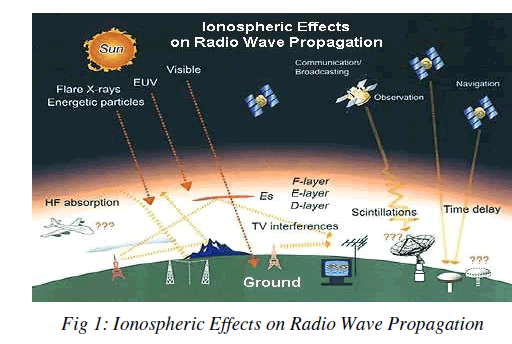 |
III. SUNSPOTS AND SOLAR INFERNOS |
A. Sunspots |
| Sunspots are temporary phenomena on the photosphere of the sun that appear visibly as dark spots compared to surrounding region. Like magnets they also have two poles. These sunspots can expand and contract and move along with the photosphere of the sun can be as large as 80,000 km in diameter making the larger ones visible from the earth without the aid of telescope. |
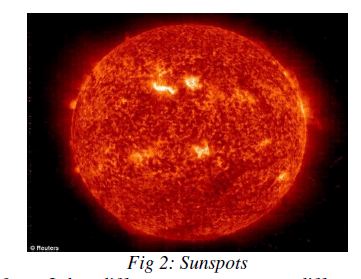 |
| Temperature on the sun is non-uniform. It has different temperatures at different regions. One of the reasons for the formation of spot is, intense magnetic activity developed at reduced surface temperatures as in fig.2. Another reason for the formation of sunspots depends on solar rotation. Sun’s rotation is also non uniform. When compared to poles equator rotates very fast and this rotation is called Differential Sun’s Rotation (DSR) or Differential Solar Rotation. |
| Due to this differential rotation, sunspots and many other solar activities are formed. These sunspots generally vary every 11 years a cycle and currently we are in 24th Cycle. It is difficult to count the accurate number of sunspots present on sun but the average number of sunspots are observed each day by Smoothed Sunspot Number i.e. SSN number. Temperatures in the dark spots vary about 3700 K (compared to 5700 K for the surrounding photosphere). They typically last for several days, although very large sunspots may last for several weeks. The differential Solar Rotation can be compared to a Rubix Cube as shown in the fig 3:- |
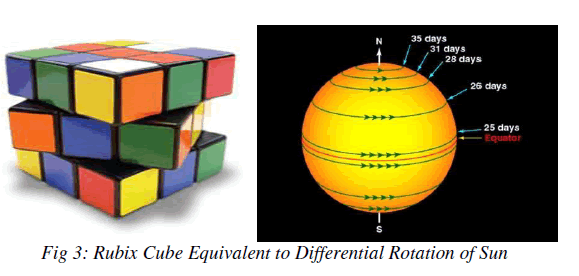 |
B. Solar Infernos |
| Solar Infernos are a massive tremendous violent explosions and a sudden brightening observed over the surface of the sun. These solar flares or solar infernos are erupted from sunspots. Along with these flares, UV rays, cosmic rays, X-rays and all other gasses like hydrogen, helium are produced as in fig.4. Whenever the accelerated charged particles (mainly electrons) interact or react with the plasma medium present on the sun these massive solar flares are occurred. Solar flares are classified as A, B, C and M or X depending on the peak intensity. Each class has peak intensity ten times more than the preceding one i.e. X>C>B>A. X class or M class flares are most powerful flares which shows a variety of effects on the Earth’s environment. Whereas the flares which has less intensity increases the ionization of the upper part of the atmosphere and interfere with short radio waves and improves radio communications. |
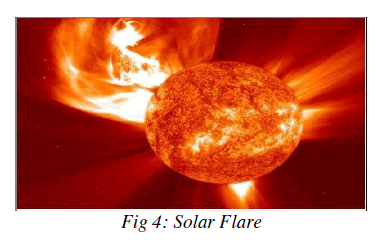 |
| C. Use Of Solar Infernos For Efficient Working Of Communication Equipment |
| This paper deals, how the efficient communication can be done by utilising solar infernos erupted from sun. Now let us see the co-relation between sunspots and propagation conditions. Number of sunspots varying during a period of sunspot cycle can be treated in two ways:- |
| SUNSPOT MAXIMUM:- It means large number of sunspots and high solar surface activity on the photosphere of the sun. |
| SUNSPOT MINIMUM: - It means less number of sunspots and low solar activity on the photosphere of the sun. |
| Whenever the high frequency electromagnetic wave transmitted from the transmitter, hits the ionosphere, reflection to the desired destination depends on the coefficients of reflection and absorption. If sun is more active more spots are generated and more radiation is produced which can affect the Earth’s ionosphere. Therefore when infernos are high Ionosphere’s reflection coefficient is extremely high and absorption is almost zero which provides worldwide propagations. |
| The ability of the ionosphere to reflect high frequency radio signals depends on amount of solar radiations. Solar activity influences all radio communications beyond ground wave or line of sight. When sun is active frequencies up to40MHz or more can be useful for long wave communication all over the globe. Hence by these infernos efficient communications are obtained. The device which is used for ionosphere communication is HAM Radio shown in fig.5. |
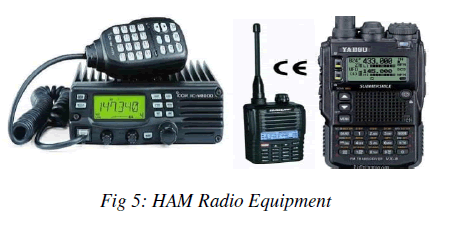 |
D. Solar Flux |
| By determining the solar flux, ideal propagation can be obtained. Radiation from the sun can be determined at several radio frequencies, out of which 2800MHZ with a wavelength of 10.7 cm is commonly used. The signal which transmits with this frequency is termed as Solar Flux. By measuring this one can determine the affect of radiation by the sun on ionosphere. Higher value of solar flux indicates that high frequencies can propagate. There is also a relation between SSN number and solar flux i.e. as SSN number increases from 0 to 200, flux varies from 60 to 300. |
Advantages:- |
| 1. Increase of spots activity increases the ionization and improves radio propagation. |
| 2. Ionization can be done even at night times by cosmic rays. |
| 3. A class flares and B class flares gives effective ionization without affecting the earth. |
| 4. Devices like HAM are much efficient in ionospheric propagation. |
| 5. Infernos do not last for many hours. |
Disadvantages:- |
| 1. Most powerful radiations like X class radiations effects the earth. |
| 2. Temperature may increase more and more |
| 3. There are also health issues for pilots and astronauts |
| 4. Lack of ozone layer extensive UV radiations may reach the earth. |
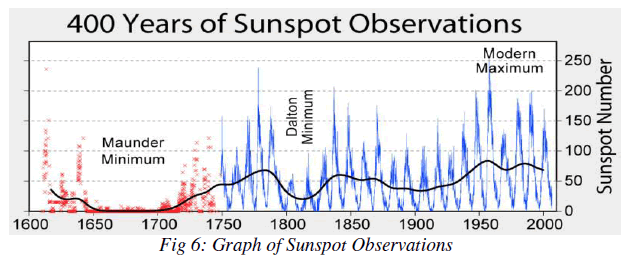 |
| The era of Radio astronomy began in 1931 although invention of telescope took place in 1608. Hence from the above graph (fig.6) it is evident that the disasters that took place in the period of 1600 to 1900 are less compared to disasters occurring in the period of 1900 to 2000. |
E. SPECTROHELIOSCOPE to Examine Sunspots |
| A spectrohelioscope is a type of solar telescope designed by George Ellery Hale in 1924 to allow the Sun to be viewed in a selected wavelength of light. The basic spectrohelioscope as shown in fig.7 is a complex machine that uses a spectroscope to scan the surface of the sun. The image from the objective lens is focused on a narrow slit revealing only a thin portion of the sun’s surface. The light is then passed through a prism or diffraction grating to spread the light into a spectrum. The spectrum is then focused on another slit that allows only a narrow part of the spectrum (the desired wavelength of light for viewing) to pass. The light is finally focused on an eyepiece so the surface of the Sun can be seen. The view, however, would be only a narrow strip of the Sun's surface. The slits are moved in unison to scan across the whole surface of the sun giving a full image. Independently nodding mirrors can be used instead of moving slits to produce the same scan: the first mirror selects a slice of the sun; the second selects the desired wavelength. |
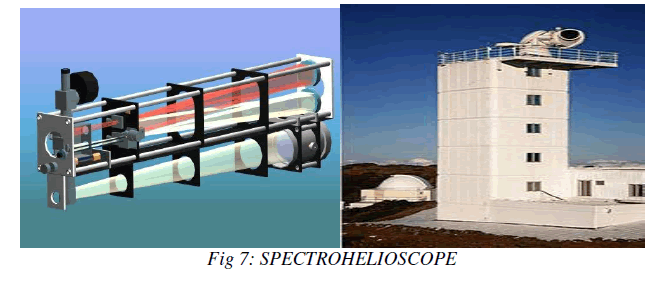 |
IV. EXAMPLES WHERE COMMUNICATIONS HELPED AT DISASTROUS TIMES |
V. CONCLUSION |
| Today there is the need for conservation of natural resources as there is decline in plenty of resources. Development of eco-friendly measures such as increasing the use of solar power gadgets can minimize power consumptions where an abundant hydroelectric and thermal power can be saved (fig.8). This type of measures can reduce man-made disasters to a possible extent. Communication plays a vital role in the advent of a disaster. So it would be wise to develop gadgets like HAM Radios which are amiable to nature rather than using high radiation mobiles which harms both people and Mother Nature. Though disasters in the sun like Solar Infernos, Sun Spots and Solar Flares increase our earth’s temperature, we could still utilize these disasters for enhancing our communication and to look forward for a better world of tomorrow. |
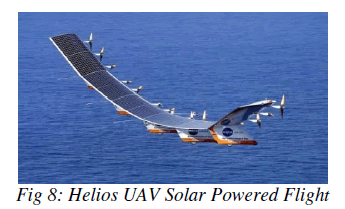 |
References |
|